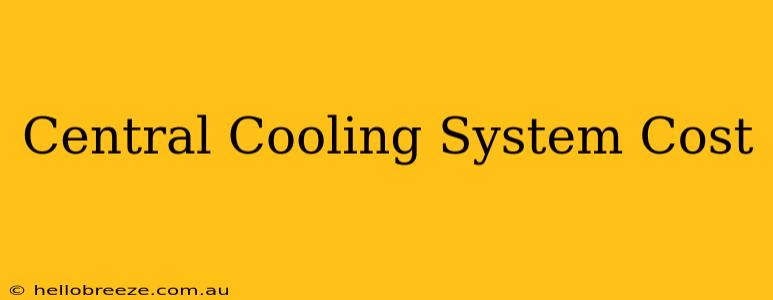Thinking about installing a central cooling system? It's a significant investment, so understanding the costs involved is crucial. This guide breaks down the various factors influencing the central cooling system cost, helping you budget effectively.
Factors Affecting Central Cooling System Costs
Several factors contribute to the overall expense of a central cooling system. These include:
1. System Size and Type:
The size of your home or building directly impacts the required cooling capacity. Larger spaces necessitate larger, more powerful systems, leading to higher initial costs.
The type of system also plays a significant role. Common types include:
- Split systems: These are the most common, comprising an outdoor unit and an indoor evaporator coil. Costs vary depending on the efficiency rating (SEER).
- Packaged systems: These units combine all components in a single cabinet, typically suitable for smaller spaces.
- Geothermal systems: While offering long-term energy savings, these systems have significantly higher upfront installation costs.
- Chilled water systems: These are typically used in larger commercial buildings and are considerably more expensive than residential systems.
2. Installation Complexity:
The complexity of the installation significantly affects the central cooling system cost. Factors include:
- Accessibility: Difficult-to-reach areas or obstacles can increase labor costs.
- Existing ductwork: If your home has existing ductwork suitable for the new system, it will be cheaper than installing new ductwork. New ductwork installation can dramatically inflate the total cost.
- Electrical work: Significant electrical upgrades may be needed to accommodate the new system, adding to the expense.
3. Equipment Efficiency:
Higher efficiency systems (measured by the Seasonal Energy Efficiency Ratio or SEER) generally cost more upfront but provide greater long-term energy savings. A higher SEER rating means lower energy bills over the system's lifespan. Consider the return on investment when choosing between different efficiency levels.
4. Geographic Location:
Labor costs and material pricing vary by geographic location. Areas with higher labor costs will generally have higher installation expenses.
5. Permits and Inspections:
Remember to factor in the costs associated with necessary permits and inspections. These requirements vary by location.
Estimating Central Cooling System Costs
While it's impossible to provide an exact price without a professional assessment, here’s a general range:
- Basic split system installation: $3,000 - $8,000
- High-efficiency split system installation: $5,000 - $15,000
- Packaged unit installation: $2,000 - $6,000
- Geothermal system installation: $20,000 - $50,000+
These are just estimates; the actual central cooling system cost will depend on the factors outlined above.
Getting Accurate Estimates
To obtain accurate estimates, contact multiple reputable HVAC contractors in your area. Request detailed quotes that specify the system components, installation details, and any additional costs. Don't hesitate to ask questions to ensure you fully understand the breakdown of the price.
Choosing the Right Central Cooling System
Selecting the right central cooling system requires careful consideration of your needs and budget. Factors like home size, energy efficiency goals, and budget constraints should guide your decision. A consultation with a qualified HVAC professional will help determine the optimal system for your specific requirements.
Remember: The initial cost is only one aspect of the overall expense. Consider the long-term energy savings provided by a more efficient system. This could ultimately offset the higher upfront investment. Investing in a reliable and efficient system will ensure comfortable temperatures and long-term savings.

